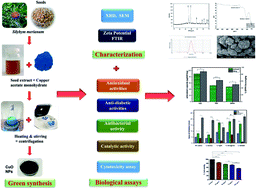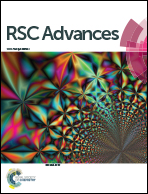Potential antimicrobial, antidiabetic, catalytic, antioxidant and ROS/RNS inhibitory activities of Silybum marianum mediated biosynthesized copper oxide nanoparticles
Abstract
Use of medicinal plants for the biosynthesis of nanoparticles offers several advantages over other synthesis approaches. Plants contain a variety of bioactive compounds that can participate in reduction and capping of nanoparticles. Plant mediated synthesis has the leverage of cost effectiveness, eco-friendly approach and sustained availability. In the current study Silybum marianum, a medicinally valuable plant rich in silymarin content, is used as a reducing and stabilizing agent for the fabrication of nanoparticles. Biosynthesized CuO-NPs were characterized using High Performance Liquid Chromatography (HPLC), Fourier Transform Infrared Spectroscopy (FTIR), X-ray Diffraction (XRD), Scanning Electron Microscopy (SEM), and Dynamic Light Scattering (DLS) techniques. Characterization revealed that CuO-NPs having a crystalline structure showed spherical morphology with an average size of 15 nm. HPLC analysis demonstrated conjugation of various silymarin components, especially the presence of silybin A (705.06 ± 1.59 mg g−1 DW). CuO-NPs exhibited strong bactericidal potency against clinically important pathogenic bacterial strains e.g. Enterobacter aerogenes and Salmonella typhi with an inhibition zone of 18 ± 1.3 mm and 17 ± 1.2 mm, respectively. Synthesized nanoparticles indicated a dose dependent cytotoxic effect against fibroblast cells exhibiting a percentage cell viability of 83.60 ± 1.505% and 55.1 ± 1.80% at 25 μg mL−1 and 100 μg mL−1 concentration, respectively. Moreover, CuO-NPs displayed higher antioxidant potential in terms of (TAC: 96.9 ± 0.26 μg AAE/mg), (TRP: 68.8 ± 0.35 μg AAE/mg), (DPPH: 55.5 ± 0.62%), (ABTS: 332.34 μM) and a significant value for (FRAP: 215.40 μM). Furthermore, enzyme inhibition assays also exhibited excellent enzyme inhibition potential against α-amylase (35.5 ± 1.54%), urease (78.4 ± 1.26%) and lipase (80.50.91%), respectively. Overall findings indicated that biosynthesized CuO-NPs possess immense in vitro biological and biomedical properties and could be used as a broad-spectrum agent for a wider range of biomedical applications.



 Please wait while we load your content...
Please wait while we load your content...